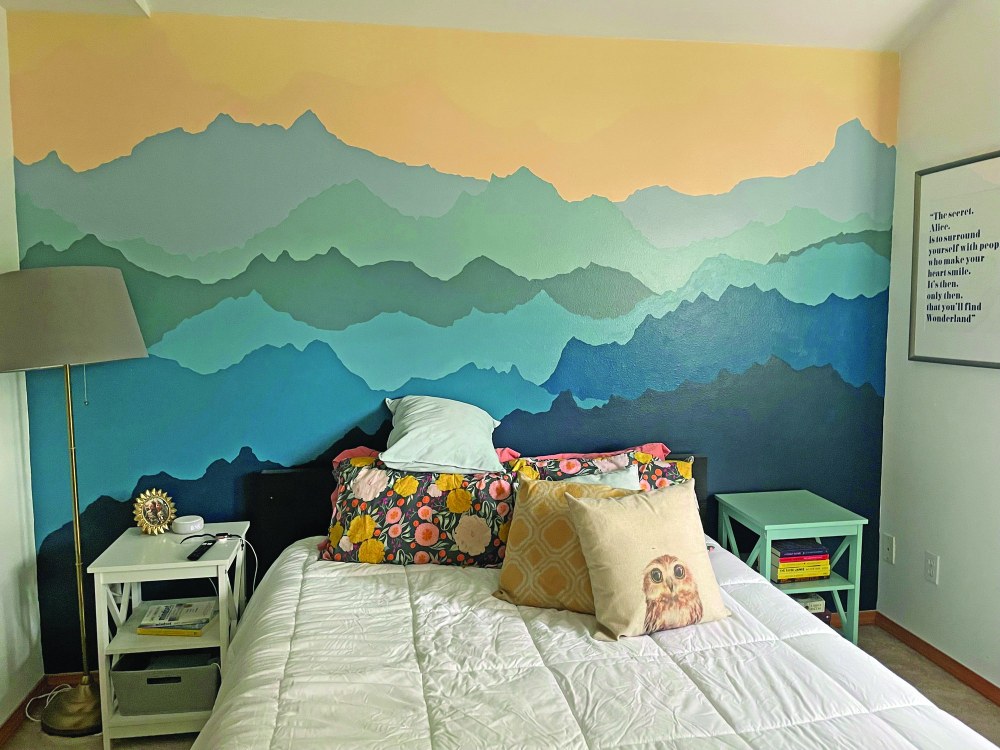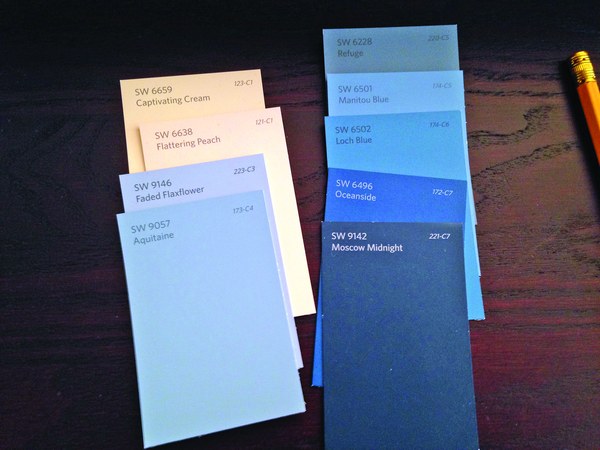
Calm, centered, present, and grateful. Spending time outdoors makes me feel all of these things and more. A few years ago, I was inspired to bring that serenity indoors. Into my bedroom, specifically, via a mountain mural on the wall.
Like any intrepid Mountaineer, I started my journey with research. I only found a few ‘how to paint your own’ resources, none of which seemed possible for a mere mortal, and the fancy mural wallpaper was out of my price range. I loved paint-by-numbers as a child, so I opted to rely on memory and luck to figure it out. After a few starts at stops, and about 16 hours of painting the 11’x8’ wall, I had my completed design. It still brings me peace anytime I walk into the room.
If you are looking for a sign that it’s time to freshen up your space, here are seven easy steps to paint a mountain mural. Keep in mind these instructions are meant to be approachable and don’t involve any fancy shadows or shading. You can always add those later if you’re artistically inclined.
1.Identify and prep your blank canvas. Locate an empty wall of reasonable size. You should probably own this wall, because you can’t take wall murals with you. Paint it white.
2.Select your colors. Go to the paint store. If you’re like me, you’ll spend at least an hour putting different colors in cascading order until you have the right mix for your masterpiece. I recommend seven to nine colors (odd numbers look better) in 1/2-1 pint cans. You’ll need enough for two to three coats of each color. (I thought the colors were the crux of the entire endeavor, and recruited a friend to help me. I’ve included the colors I selected in case it’s helpful.)
 Feel free to borrow Lisa’s excellent color selection. Next time I’d go with a starker (and more pink) contrast between the two colors of the sky.
Feel free to borrow Lisa’s excellent color selection. Next time I’d go with a starker (and more pink) contrast between the two colors of the sky.
3.Draw your outline. Using a pencil, lightly sketch the different mountain layers on the wall to provide a general outline of where you want the different colors to meet. These outlines do not need to be perfect – you’ll add details later – but I do recommend looking at a few mountain photos for inspiration. Make sure to note where furniture will be located in front of your masterpiece. It will help you decide where to put your mountain layers (for example, I painted a wider bottom layer than I might have because it was going behind a bedframe and nightstand).
4.Paint your first layer. I numbered my layers one through nine, from lightest (at the top of the mural) to darkest. I started on top, but recommend starting with the darkest color on the bottom because it’ll require the most layers. The first strokes will be nerve-wracking. Use a big brush to give yourself a general outline and fill in the area. You will come back later and use a small brush to add detail.
5.Continue to paint, alternating layers. You don’t want to be painting a new color next to the color that is still drying. Paint the bottom – or darkest – layer (in my case #9) first, then alternate at least one layer away so you won’t have any overlap. Darker colors will need three coats, and lighter colors will require two coats plus touch-up work. After painting the top layer, I skipped a layer to paint the next one down (#3). This allowed #1 to dry. Then I could paint #2 and so forth.
6.Apply your second coat. Taking what you learned on all of your layers in your first coat, paint your second coat. Now that you know what you’re doing, pick the method you think is best. At this stage, you can begin adding details along the edges if you want.
7.Add the detail. With the border set between layers, grab a small paintbrush and use paint #2 to add details overtop paint layer #1. You’ll likely need to go over the detailed borders twice. It’s easiest to paint the details as though they come from the bottom layer onto the top layer, which is why I used paint #2 to add details on top of paint #1, and used paint #3 over top #2, and so forth. This assures the bottom layer is more prominent in its detail.
Enjoy your space! That’s it, now it’s time to put your furniture in place and enjoy the fact that you’ve brought the outdoors in. Kick back and enjoy the view.
 Kristina painting with her friend Lisa Bowers.
Kristina painting with her friend Lisa Bowers.
TIPS FOR SUCCESS
- Set aside a few days to get this done. I already had the room taped and prepped to cover up hideous red paint from the previous occupants. Prep always takes more time than you think it will, so plan accordingly. Painting my mountain mural took about 16 hours.
- Get flat paint. Paint comes in different ‘sheens.’ Higher sheens are shinier and more durable (that’s why higher-gloss is used in bathrooms). Flat paint has no shine, followed by eggshell, satin, semi-gloss, and high-gloss. I got an eggshell, but wish I had gone with a flat paint, even on a textured wall. Flat paint allows you to see your artwork better.
- Spend money on good brushes. Get a big brush for edging and general application, a medium-sized brush for touch up work, and a very small brush for the detail work.
- Embrace imperfection. My outline started with parallel and sweeping lines – it’s natural to make a perfect mound with a paintbrush – but once you fill in the colors, it will look like Dr. Seuss took a mountain-shaped poo on your wall. Take a small brush and create smaller bumps and mounds and sharp edges. Imperfections are good. They make the landscape look real.
- Remember this is an investment in your new home. The paint – plus painters tape, plastic, and brushes – will run you about $200. This ain’t your kid’s paint-by-number.
This article originally appeared in our summer 2023 issue of Mountaineer magazine. To view the original article in magazine form and read more stories from our publication, visit our magazine archive.
Add a comment
Log in to add comments.Beautiful! Thanks for the step-by-step. I made a string art installation of Mt. Rainier, perhaps it will be cool enough to feature in a future magazine issue :)
This is awesome Kristina! Thanks for sharing the process. I would too have taken an hour or many more on putting the colors in order. :)
 Kristina Ciari Tursi
Kristina Ciari Tursi